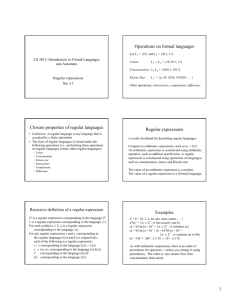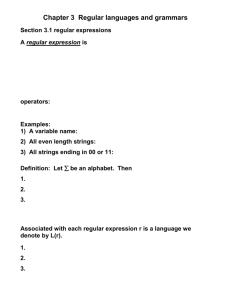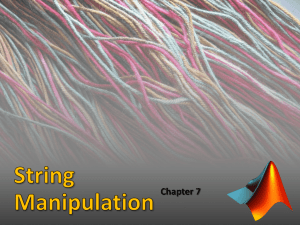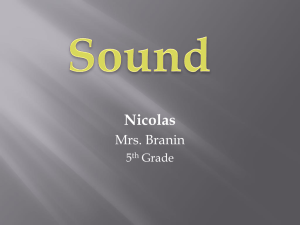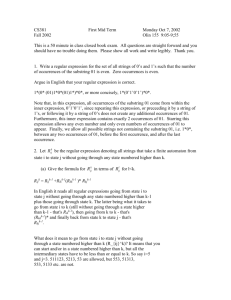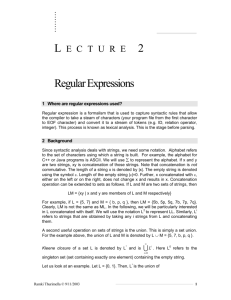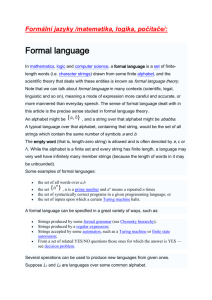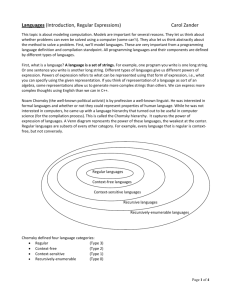HW03 Solution
advertisement
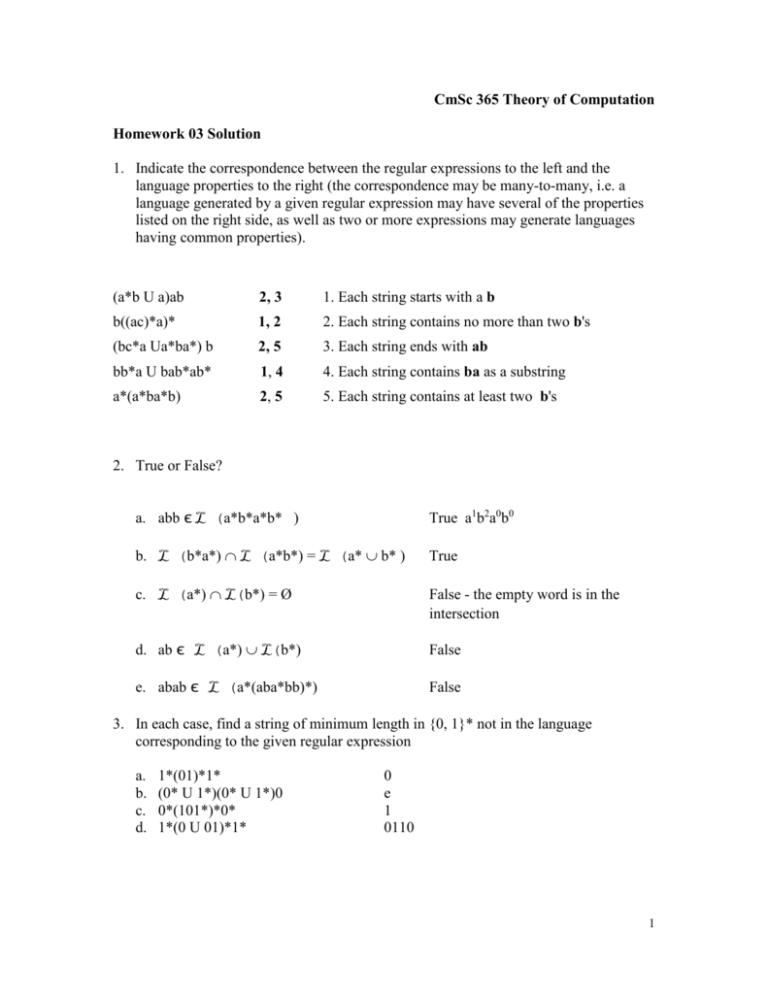
CmSc 365 Theory of Computation
Homework 03 Solution
1. Indicate the correspondence between the regular expressions to the left and the
language properties to the right (the correspondence may be many-to-many, i.e. a
language generated by a given regular expression may have several of the properties
listed on the right side, as well as two or more expressions may generate languages
having common properties).
(a*b U a)ab
2, 3
1. Each string starts with a b
b((ac)*a)*
1, 2
2. Each string contains no more than two b's
(bc*a Ua*ba*) b
2, 5
3. Each string ends with ab
bb*a U bab*ab*
1, 4
4. Each string contains ba as a substring
a*(a*ba*b)
2, 5
5. Each string contains at least two b's
2. True or False?
a. abb є L (a*b*a*b* )
True a1b2a0b0
b. L (b*a*) L (a*b*) = L (a* b* )
True
c. L (a*) L(b*) = Ø
False - the empty word is in the
intersection
d. ab є L (a*) L(b*)
False
e. abab є L (a*(aba*bb)*)
False
3. In each case, find a string of minimum length in {0, 1}* not in the language
corresponding to the given regular expression
a.
b.
c.
d.
1*(01)*1*
(0* U 1*)(0* U 1*)0
0*(101*)*0*
1*(0 U 01)*1*
0
e
1
0110
1
4. Find a regular expression corresponding to each of the following subsets of {0,1}*:
Note: Below, for each language only one regular expression is given. However there
may be other regular expressions that generate the same language.
Example 1: The regular expression for the language that contains at least two
occurrences of the substring “11” will be (0 U 1)*11(0 U 1)* 11(0 U 1)*
First write what is required and then surround and insert in between all possible
strings
Example 2: The regular expression for the language that contains two types of strings:
starting with one or more 1’s and ending with zero or more 0s, and starting with one or
more 0s and ending with zero or more 1s is
11*0* U 00*1*
a. The language of all strings containing exactly two 1’s
0*10*10*
b. The language of all strings containing at least two 1’s
b1) (0 U 1)*10*1(0 U 1)*,
b2) (0 U 1)* 1 (0 U 1)* 1 (0 U 1)*
b2) generates the same strings as b1), b1) is shorter.
c. The language of all strings that end with 01
(0 U 1)* 01
d. The language of all strings that begin with 11 and/or end with 00
d1) 11(0 U 1)* U (0 U 1)*00
d2) 11(0U1)* U (0U1)*00 U 11(0U1)*00
d2) generates the same strings as d1) because 11(0U1)*00 is contained in
11(0U1)* U (0U1)*00
e. The language of all strings in which every 0 is followed immediately by 1
e1) (1 U 01)*
e2) 1*(011*)*
e3) 1*(011*)*1*
2
In e3) the last 1* is not necessary because the 1’s at the end of a string can be
generated by 1* in (011*)
f. The language of all strings containing 1111 as a substring
(0 U 1)* 1111 (0 U 1)*
5. Given and alphabet , the set of all possible strings over including the empty string
is denoted by *.
Let L = {a,b}* . The regular expression that describes all strings in L is (a U b)*
Apply the above definitions to solve the following problems:
a. The languages below are described as sets. Write the corresponding regular
expressions for each of them
L = {ab,ba}*
L = {ayb: y {a,b}*}
(ab U ba)*
a(a U b)*b
Note that (ab)* is different from a*b*
b. For each regular expression below, give the set description of the
corresponding language
ab(a U b)*
L = {abw | w {a,b}*}
(a U ab)*
L = {a, ab}*
6. Given and alphabet , and two languages L1 , L2 *, L1 L2 is defined in the
following way;
L1 L2 = {xy : x L1 and y L2}
a. Let L1= {hope, thought}, L2 = {less, ful}. Write down the elements of L1 L2.
L1 L2. = {hopeless, hopeful, thoughtless, thoughtful}
b. Let L1 be represented by the regular expression (a* U b*), and L2 be represented by
ab. Write down the regular expressions that represent the following languages:
L1 L2
(a* U b*)ab
L1 L2
a* U b* U ab
L1 L2
3



